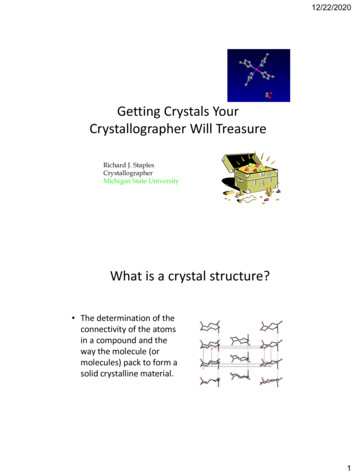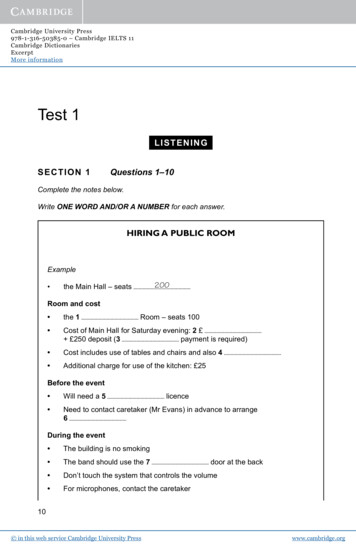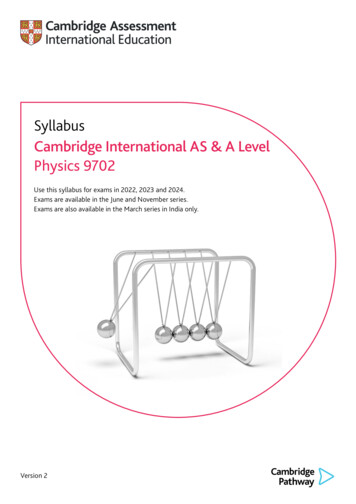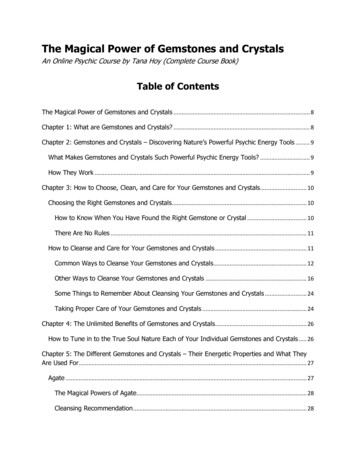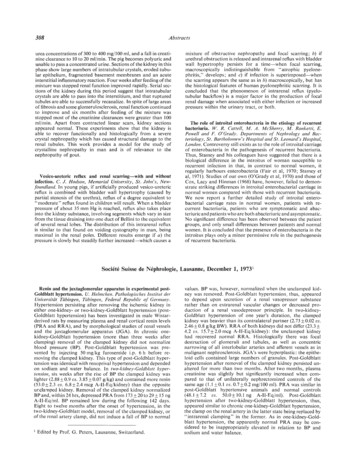
Transcription
Time Crystals
Symmetry and its spontaneous breaking areat the heart of our modern understanding ofthe physical world.Spontaneous breaking of spatial translationsymmetry is, of course, very common (ascommon as crystals).It is easy to construct mean field theories forthat phenomenon:
V (φ) µ ( φ) λ(( φ) )2V (φα ) Qαβ2 i φα φβ Λiαβγδ2 2ij i φα φβ j φγ φδ
Inspired by special relativity, or simply byanalogy, it is natural to consider thepossibility of spontaneous breaking of timetranslation symmetry.This turns out to bring in some surprisingnovelties.
Classical Time Crystals
1. At first sight, looking at the Hamiltonequations, the idea seems like a non-starter:
ṗj j q̇Minimum energy H j q H pjnothing moves (it seems)
2. On the other hand, the Lagrangiananalogue of our earlier, “crystalline” potentialV suggests something different:
1 4 κ 2L φ̇ φ̇423 4 κ 2E φ̇ φ̇42at energy minimum:2φ̇κ 3
3. What has happened here?The point is that our innocuous-looking Lleads to a cuspy H(p):
3 4 κ 2E φ̇ φ̇423p φ̇ κφ̇κ .5
The energy minima occur at the cusps, sothey needn’t - and don’t! - have horizontalslopes.
4. When we add a potential, the energy becomes3 4 κ 2E φ̇ φ̇ V (φ)42If we choose initial conditions to minimize both the kineticpart and V, we’ve got a problem!
5. More generally, the equation of motionδVκφ̈(φ̇ ) 3δφ2breaks down at2φ̇κ 3unless the right-hand side also vanishes there.
6. On the other hand, we are safe for1 2E κ Vmax.12
7. The connection between “breakdown” ofthe equation of motion and breaking of timetranslation symmetry (i.e., motion in theground state) is general:
E E φ̇k Lφ̇j L φ̇j2 Lφ̇j φ̇j φ̇k! L ". 2L φ̈j . φ̇k φ̇k φ̇j(eqn. of motion) E 0So if the energy minimization condition φ̇k0has a non-trivial solution φ̇j , then the eqn. of motiondoes not constrain the component of acceleration 0φ̇j
8. It is understandable that it shouldn’t betoo easy to get spontaneous motion.If we have motion associated with theminimum energy, then we must have a wholecurve of states with that minimum energy;and that degeneracy requires specialconditions.Are there non-trivial models?
Yes there are, two kinds:Fine-tuned.Natural, connected with brokensymmetry.
9. Lagrangians of the formL f φ̇ g φ̇ h42for functions f, g,h lead to energies of the formE So if3f φ̇4 g φ̇2 h2gg223f (φ̇ ) h.6f12fg2 h const.12fthe energy is indeed minimized on a curve, for anyf 0, g 0).
The energy will be minimized for2φ̇0g 6fIn this way we see that any orbit with a velocity thatdoes not change sign can be realized, in many ways, asthe stable minimum of an appropriate, reasonably simpleLagrangian.10. Semi-classical quantization can avoid the singular zone,even with (small) potentials.
11. We can also get natural models by havingthe trajectories move along the orbit of aspontaneously broken symmetry. This is aninteresting and promising direction.12. Special cases: “Universal” Q ball, currentcarrying ground state, traveling densitywaves, .
Quantum Time Crystals
1. Quantum mechanically, one has a similar(apparent) “no-go”:!ψ Ȯ ψ" i!ψ [H, O] ψ" ? 0would appear to vanish for the groundstate, for any potential order parameter ofmotion.
2. Also: A system with spontaneous τbreaking appears perilously close to being aperpetual motion machine.3. Also: By what criterion are we going topick out “ground states” that break τ (sinceminimizing H won’t do it)?
And Yet .
1. In the right circumstances, supercurrentswill flow forever in the ground state.This is suggestive; though if the current isconstant, time translation symmetry τ is notbroken. (Time-reversal T of course is).
2. We can capture an important part of theessence of the matter by considering a verysimple quantum mechanical model, to wit acharged particle on a ring threaded bymagnetic flux.
1 2L φ̇ α φ̇212H (πφ α)212El (l α)2!l φ̇ l" l α
Thus if α is not an integer*, the groundstate will support non-zero !l0 φ̇ l0 "This is a direct consequence of the quantization of(canonical) angular momentum.Since φ̇ is neither the time derivative of a welldefined operator, nor the commutator of theHamiltonian with one, there is no contradiction.*(The half-odd integer case requires special consideration.)
Time reversal T is generally broken( intrinsically*, usually), but not timetranslationτ .
3. What might appear to be a specialdifficulty with breaking τ , because of itsconnection to the Hamiltonian, actuallyarises for all cases of spontaneous symmetrybreaking. Consider a complex orderparameter that acquires a non-zero vacuumexpectation value, which we can take to bereal:!0 Φ 0" v # 0
We will also have alternative energeticallydegenerate, orthogonal** states with arbitrary valuesof the phase!σ Φ σ" veiσThe superposition1 Ω! 2π!2π0dσ σ!is therefore energetically degenerate, and moresymmetric:!Ω Φ Ω" 0
**The different σ states are orthogonal inthe limit of infinite volume (or, moregenerally, an infinite number of correlateddegrees of freedom), because we mustmultiply smaller-than-unity overlap factorsinfinitely many times.
Ψσ (x1 , ., xN ) !Ψσ! Ψσ " N!j 1N!ψσ (xj )j 1!ψσ! ψσ " (fσ! σ )N 0 (σ ! % σ)
The comment (**) is also the key to why weprefer the σ states to Ω. No finite product oflocal observables connects different σ states, soany world of observation will correspond to asingle σ state:
!Ψ O1 (xa , xb )O2 (xc , xd , xe ). Ψσ "σ!(σ % σ)" (fσ! σ)N finite 0
Thus the physical criterion that identifies useful“ground states” is not simply energy, but alsoobservability.The infinite volume (or infinite DOF) limit iscrucial here; finite systems cannot exhibitspontaneous symmetry breaking.
ModelExistence Proof
With this background, we are ready toconstruct a simple model of τ violation.We take an infinite number (N ) ofcopies of our ring-particles, with an identicalattractive δ-function interaction betweeneach pair.
H N!1j 1!λ2(πj α) δ(φj φk )2N 1j! k
The particles will want to be in the sameplace, and (for noninteger α) they will wantto move.So we can expect to get a moving lump.Such a dynamical configuration will violate τ,giving us a time crystal.
Consider first α 0.We take a product wave-function ansatz, andsaturate with it (“mean field” approximation).(Operationally, we define an effective Veff.(Φ) with ψ(Φ) Veff.(Φ) ψ(Φ) Ψ(Φj) V(Φj) Ψ(Φj) by integrating over N-1 variables.)
In this way we arrive at a non-linearSchrödinger equation. Its localized “soliton”solution, constrained to be periodic, can beexpressed in elliptic functions:
From Faraday’s law, we can expect that turning on the flux,i.e. cranking up α, torques the lump in a simple way.In fact we both boost and “gauge-transform”, to getinteracting versions of our earlier l states.
Specifically: We can solve ψl122i ( i φ α) ψl λ ψl ψl t2withψl (φ, t) e ilφ ψ̃(φ (l α)t, t)and ψ̃1(l α)22i ( i φ ) ψ̃ λ ψ̃ ψ̃ ψ̃ t222
The minimal energy solution occurs for theminimum value of (l α). If that quantity isnot an integer, the solution is a moving lump.τ is then broken.
Discussion
Were we literally talking about chargedparticles, we’d have to worry about couplingto the (dynamical) electromagnetic field,leading to radiation.Formal mechanism: “Long-wavelength”photons couple to all the ϕj. The timeevolution operator, which exponentiates thisinteraction, is non-local.So we should expect relaxation to the Ωstate.
We can ameliorate this by using multipoles,or by putting a gap in the photon spectrum,e.g. by working in a cavity, insuring slow andpossibly inconsequential relaxation.
On more philosophical and speculativenotes:We’ve been discussing the spontaneousemergence of clocks.More complex systems of this kind,taking excursions in a large, structuredHilbert space, could be quantumcomputers capable of dodging the heatdeath of the universe for a very longtime.
Imaginary Time Crystals
We represent the partition function as an integralover all configurations periodic in Space-iTime, withiTime period β 1/T, weighted by e-S.Thus the partition function for a d-spatial dimensionsystem is a weighted sum over d 1dimensionalEuclidean field configurations.If the ground state of the d 1 dimensional theory iscrystalline, the partition function will be dominatedby iTime crystals.
The crystal structure will fit without distortion ifand only if the iTime lattice period divides β 1/Tevenly.Thus a signature for iTime crystalline states is someapproximately periodic behavior in 1/T, especiallyfor small T.
Directions
Many questions and possibilities for development arise:Directed 0-point motion, more generally?Concrete, practical realizations?T 0 in real time?Classification of space-time and space-iTimecrystals.All the usual SSB questions: excitation spectrum,phase transitions (critical dimensions), defects, .
END[slide dump follows]
Sombrero Doble
1. To support motion in the ground state, wewant constant energy along its orbit. Orbitsof constant energy are typically associatedwith symmetry, so it is natural to look forrealizations in systems with symmetry.
2. The simplest example structure,conceptually, is a double Mexican hat, orsombrero doble. We envision a radial field ρwith a sombrero potential governing itsmagnitude; and an associated angular field ϕof the type we’ve been discussing, with asombrero kinetic Lagrangian.
3. The polynomial building blocks for invariant termsinclude:2ψ̇2 ψ1 ψ̇2 ψ2 ψ̇1! 2"2 .ψ1 ψ2 ρ φ̇ 2ρρ̇ 22ψ̇12ψ1 2ψ2ρ̇ ρ φ̇22 22ρ4. The sort of structure we want will appear if we have thesquare of the second term appearing with a negativecoefficient, controlled by the square of the first term.There is considerable latitude, given that core structure.
As κ changes sign, the qualitative form of theenergy function changes. It is the unfoldingof a mathematical “catastrophe”.
H0.300.250.200.150.10κ -.50.05!0.3!0.2!0.10.10.20.3p
Dynamics (and“Soundness”) of the fghModel
1. As a sort of existence proof / sanity check, I’d like todemonstrate that the fgh model has sensible dynamics, anda good initial value problem in general (not just forf,g,h const.).2. The energy is!g "2E f φ̇ 6f2and sogφ̇ 6f2!Ef(Recall f 0, g 0; and obviously E 0.) This is theequation for motion in an effective potential.
gφ̇ 6f2!EfThus we can use our experience in mechanicsto anticipate the motion.3. Assume for simplicity f 1. Then we have motion inthe (negative) effective potentialVeff.g 6fwith the effective, “fictitious” energyEeff. E 2Eeff.E
4. It’s entertaining, I think, that the boundedmotions have higher energy than manyunbounded motions.
equations, the idea seems like a non-starter: p . reasonably simple Lagrangian. 10. Semi-classical quantization can avoid the singular zone, even with (small) potentials. . The comment (**) is also the key


